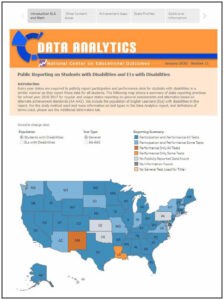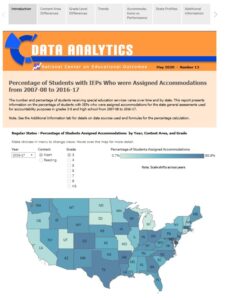NCEO has published three new interactive Data Analytics reports. Two reports provide a way for users to visualize and understand trends in assessment participation and accommodations use for students with disabilities over time. The third report explores and summarizes states’ practices on publicly reporting assessment data for students with disabilities and English learners with disabilities.
 Public Reporting on Students with Disabilities and ELs with Disabilities (Data Analytics #11) presents data on public reporting practices for assessment data for students with disabilities in K-12 schools in the United States. This Data Analytic is based on the findings in a NCEO report, 2016-17 Publicly Reported Assessment Results for Students with Disabilities and ELs with Disabilities. The purpose of this study was to analyze whether states report data for students with disabilities “to the public with the same frequency and in the same detail as it reports on the assessment of nondisabled children,” as required by the Individuals with Disabilities Education Act (IDEA).
Public Reporting on Students with Disabilities and ELs with Disabilities (Data Analytics #11) presents data on public reporting practices for assessment data for students with disabilities in K-12 schools in the United States. This Data Analytic is based on the findings in a NCEO report, 2016-17 Publicly Reported Assessment Results for Students with Disabilities and ELs with Disabilities. The purpose of this study was to analyze whether states report data for students with disabilities “to the public with the same frequency and in the same detail as it reports on the assessment of nondisabled children,” as required by the Individuals with Disabilities Education Act (IDEA).
AA-AAS Participation Rate from 2007-08 to 2016-17 (Data Analytics #12) presents data on the participation rate and percent proficient on the alternate assessment based on alternate achievement standards (AA-AAS) by grade and content across years. This report includes an interactive performance map, trends over time, and state profiles.
 Percentage of Students with IEPs Who Were Assigned Accommodations from 2007-08 to 2016-17 (Data Analytics #13) allows users to explore multiple aspects of trends in statewide assessment accommodations use across ten years. Topics that can be explored include percentages of students with disabilities who were assigned accommodations (overall, and by subject and grade), the percent of students with disabilities who both scored proficient and received accommodations, and the overall percentage of students with disabilities who were assigned accommodations over time. Users can also compare state profiles to gain insight into their state or between specific states of interest.
Percentage of Students with IEPs Who Were Assigned Accommodations from 2007-08 to 2016-17 (Data Analytics #13) allows users to explore multiple aspects of trends in statewide assessment accommodations use across ten years. Topics that can be explored include percentages of students with disabilities who were assigned accommodations (overall, and by subject and grade), the percent of students with disabilities who both scored proficient and received accommodations, and the overall percentage of students with disabilities who were assigned accommodations over time. Users can also compare state profiles to gain insight into their state or between specific states of interest.

